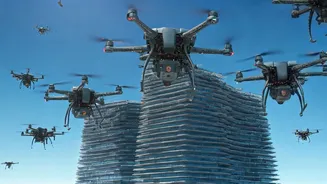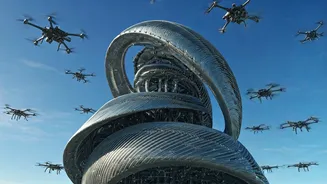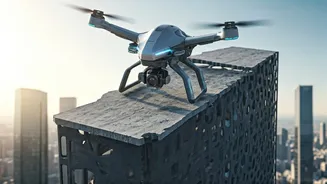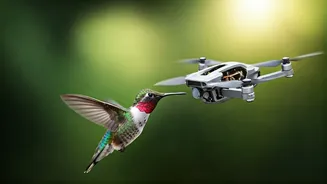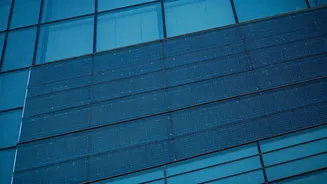Drones: The Builders
The remarkable feat of mid-air construction is achieved through the use of autonomous drones that are equipped with advanced AI. These drones are programmed
with complex algorithms and sophisticated 3D printing capabilities. They can interpret architectural designs and then, with unparalleled precision, begin the construction process. The drones collaborate, moving in a coordinated fashion as they deposit building materials layer by layer, thus forming the structure according to the pre-programmed design. This collaborative effort allows for the creation of complex and intricate forms without requiring traditional scaffolding or ground support. This approach is not only faster than conventional methods but also reduces the need for human involvement in hazardous construction environments, increasing safety and operational efficiency within the building process.
AI’s Role in Action
Central to the success of these AI-powered drones is the sophisticated AI system which controls them. The system allows the drones to make real-time decisions, adapting to variable conditions such as wind, material flow, and potential structural instability. The drones' AI system is developed to autonomously manage the construction process. It analyses the structural integrity of the growing building, correcting any imperfections or weaknesses. Furthermore, the AI ensures efficient material usage, minimizing waste and optimizing the construction process for speed and material conservation. The AI's adaptability allows the drones to handle different types of materials and design requirements, thus broadening their application scope in various construction scenarios. This innovation allows the drones to self-correct during the construction process. With a 90% success rate, it is evident that their precision and efficiency are remarkable.
The 3D Printing Approach
The drones use 3D printing techniques, which involve depositing material in successive layers to construct a three-dimensional object. In this case, the drones extrude construction materials in a precise pattern, building the structure from the bottom up or from the inside out. This method enables the creation of complex shapes and designs that are difficult or impossible to achieve with traditional construction methods. 3D printing allows the drones to adapt to different materials, offering versatility and adaptability. For instance, the drones can use materials like concrete, polymers, or even recycled materials, depending on the project's requirements. This flexibility adds to the sustainability and cost-effectiveness of the construction process. The layered approach not only allows for intricate designs but also enhances the structural integrity of the finished buildings by bonding the layers together effectively.
Transforming Construction
This drone technology has the potential to transform the construction industry. These AI-powered drones can significantly reduce construction time. Their autonomous operation can continue day and night, leading to faster project completion. They are also capable of working in challenging environments, such as disaster zones or remote areas, where traditional construction methods may be difficult. The use of drones can also mitigate safety risks, particularly in hazardous operations, because they can perform the task remotely, reducing the need for human presence in dangerous situations. Furthermore, the technology promises to reduce labor costs and increase efficiency, thus bringing a new age of innovation in the construction realm. This results in making buildings more affordable and accessible.
Future Implications
The development of AI-powered drones for construction is a significant step towards the automation of the building industry, opening up various possibilities. As the technology continues to develop, expect further advancements in design and construction techniques. The use of drones may lead to innovative architectural designs and unique structural forms. Further improvements will likely involve the creation of more robust and reliable construction systems. There are potential applications in space exploration, and these drones could be used to build habitats on other planets. This approach showcases how artificial intelligence can transform not just construction but how we conceive and build in the modern era. The technology is poised to address some of the most pressing challenges in the building sector.
